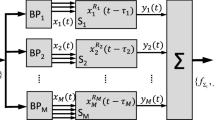Abstract
Purpose
The auditory steady-state response (ASSR) can be detected with the magnitude-squared coherence (MSC)—which is an objective response detector in the frequency domain. The performance of detection techniques is affected by the spectral leakage that arises from the Fourier analysis.
Methods
This study aimed at investigating two preprocessing techniques designed to mitigate spectral leakage: windowing and bandpass filtering. These two procedures were applied prior to the application of the MSC in the detection of ASSRs in the electroencephalogram of healthy volunteers. The ASSRs were evoked by amplitude modulated tones.
Results
Preprocessing techniques usually improve the performance of MSC, but windowing procedures were worse when compared to filtering. The filtering preprocessing improved the detection rate up to 145.7%. The false positive rates remained close to the significance level of the tests.
Conclusion
In order to mitigate the spectral leakage effects on the performance of MSC in detecting ASSR, bandpass filtering is preferred to windowing. The best results were obtained by 8th order IIR filters (Butterworth, Type 1 Chebyshev, and Elliptic).
Similar content being viewed by others
References
Breitenbach A. Against spectral leakage. Measurement. 1999;25(2):135–42.
Chen KF. Estimating parameters of a sine wave by separable nonlinear least squares fitting. IEEE Trans. Instrum. Meas. 2010;59(12):3214–7.
Diao R, Meng Q. Frequency estimation by iterative interpolation based on leakage compensation. Measurement. 2015;59:44–50.
Dobie RA, Wilson MJ. Analysis of auditory evoked-potentials by magnitude-squared coherence. Ear Hear. 1989;10(1):2–13.
Felix LB, Moraes JE, de Sá M, A. M. F. L, Yehia HC, Moraes MFD. Avoiding spectral leakage in objective detection of auditory steady-state evoked responses in the inferior colliculus of rat using coherence. J Neurosci Methods. 2005;144(2):249–55.
Harris FJ. On the use of windows for harmonic analysis with the discrete Fourier transform. Proc. IEEE. 1978;66(1):51–83.
John MS, Lins OG, Boucher BL, Picton TW. Multiple auditory steady-state responses (MASTER): stimulus and recording parameters. Audiology. 1998;37(2):59–82.
Kay SM. Detection theory, Fundamentals of statistical signal processing, vol. II. New Jersey: Prentice-Hall Inc.; 1998.
Kuwada S, Batra R, Maher VI. Scalp potentials of normal and hearing impaired subjects in response to sinusoidally amplitude modulated tones. Hear Res. 1986;21(2):179–92.
Michel F, Jorgensen KF. Comparison of threshold estimation in infants with hearing loss or normal hearing using auditory steady-state response evoked by narrow band CE-chirps and auditory brainstem response evoked by tone pips. Int J Audiol. 2017;56(2):99–105.
Miranda de Sá AMFL. A note on the sampling distribution of coherence estimate for the detection of periodic signals. IEEE Signal Process Lett. 2004;11(3):323–5.
Miranda de Sá AMFL, Infantosi AFC. Evaluating the relationship of non-phase locked activities in the electroencephalogram during intermittent stimulation: a partial coherence-based approach. Med Biol Eng Comput. 2007;45(7):635–42.
Motamedi-Fakhr S, Moshrefi-Torbati M, Hill M, Hill CM, White PR. Signal processing techniques applied to human sleep EEG signals–A review. Biomed. Signal Process. Control. 2014;10:21–33.
Picton TW, John MS, Dimitrijevic A, Purcell DW. Human auditory steady-state responses. Int J Audiol. 2003;42(4):177–219.
Raze S, Dallet D, Marchegay P. Non coherent spectral analysis of ADC using FFT windows: an alternative approach. In Intell. Data Acquis. Adv. Comput. Syst. Technol Appl. 2005:474–8.
Rebai C, Dallet D, Marchegay P. Noncoherent spectral analysis of ADC using filter bank. IEEE Trans. Instrum. Meas. 2004;53(3):652–60.
Sininger YS, Hunter LL, Hayes D, Roush PA, Uhler KM. Evaluation of speed and accuracy of next-generation auditory steady state response and auditory brainstem response audiometry in children with normal hearing and hearing loss. Ear Hear. 2018.
Smith WHF. Spectral windows for satellite radar altimeters. Adv. Space Res. 2018;62:1576–88.
Sudani S, Chen D, Geiger R. A 2-FFT method for on-chip spectral testing without requiring coherency. In Instrum. Meas. Technol. Conf. (I2MTC). 2011:1–6.
Wu X, Wang A. Harmonic signal processing method based on the windowing interpolated DFT algorithm. J. Inf. Sci. Eng. 2015;31(3):787–98.
Xi J, Chicaro JF. A new algorithm for improving the accuracy of periodic signals analysis. IEEE Trans Instrum Meas. 1996;45(4):827–30.
Yu Y, Xu Y, Liu X. Research of improved iterative DFT method in harmonic current detection. In: Power Energy Eng Conf (APPEEC). IEEE, Asia-Pacific; 2011. p. 1–4.
Funding
This work received financial support of the Brazilian Agencies: CAPES-Coordenação de Aperfeiçoamento de Pessoal de Nível Superior, CNPq–Conselho Nacional de Desenvolvimento Científico e Tecnológico and FAPEMIG–Fundação de Amparo à Pesquisa do Estado de Minas Gerais.
Author information
Authors and Affiliations
Corresponding author
Ethics declarations
Conflicts of interest
The authors declare that they have no conflict of interest.
Ethical approval
Work approved by the Local Ethics Committee. (UFV/CAAE: 56346916.4.0000.5153)
Additional information
Publisher’s note
Springer Nature remains neutral with regard to jurisdictional claims in published maps and institutional affiliations.
Rights and permissions
About this article
Cite this article
Antunes, F., Felix, L.B. Comparison of signal preprocessing techniques for avoiding spectral leakage in auditory steady-state responses. Res. Biomed. Eng. 35, 251–256 (2019). https://doi.org/10.1007/s42600-019-00021-2
Received:
Accepted:
Published:
Issue Date:
DOI: https://doi.org/10.1007/s42600-019-00021-2




